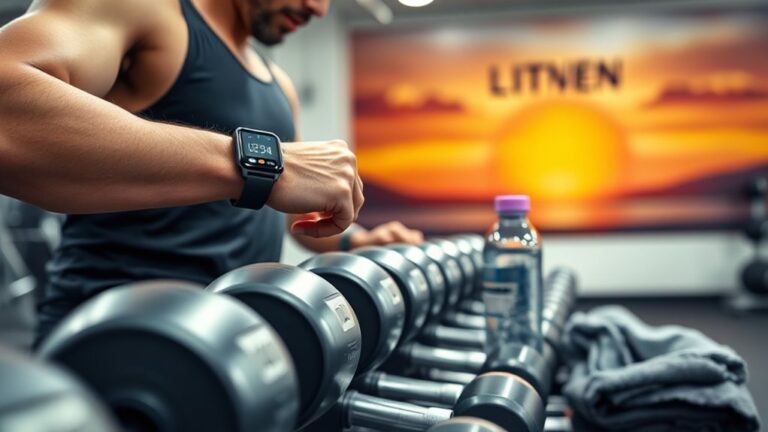How to Develop a Well-Balanced Physique

To develop a well-balanced physique, focus on strength training to build muscle and improve functional strength. Incorporate cardiovascular exercises, mixing high-intensity intervals and steady state cardio for heart health. Pay attention to your nutrition by balancing macronutrients and staying hydrated. Establish a sustainable routine that fits your lifestyle, gradually building habits. With these foundations, you can achieve the balance you seek, and there’s much more to explore about optimizing your approach.
Understanding the Components of a Balanced Physique

When it comes to developing a well-balanced physique, understanding the key components is vital. You’ll want to focus on muscle symmetry and body proportions to guarantee your appearance and functionality align. Aiming for muscle symmetry means making sure both sides of your body develop evenly, which helps prevent injuries and promotes better performance in daily activities.
To achieve this, assess your current physique and identify any imbalances. Incorporate exercises that target weaker areas while maintaining strength in stronger ones. Additionally, pay attention to your body proportions—balancing upper and lower body development is essential. This not only enhances your aesthetic appeal but also supports overall health. Engaging in activities like skipping rope can significantly improve cardiovascular endurance, which is crucial for overall fitness.
As you work on these components, remember to prioritize safety. Listen to your body, allow time for recovery, and consider professional guidance if needed. By focusing on muscle symmetry and body proportions, you’re setting a solid foundation for a well-balanced physique.
The Importance of Strength Training
Strength training is essential for achieving a well-balanced physique, as it not only builds muscle but also enhances overall functional strength. By engaging in regular strength training, you’ll promote muscle growth, which can improve your metabolism and help maintain a healthy weight. It also plays a significant role in injury prevention. Stronger muscles support your joints and reduce the risk of strains and sprains during everyday activities.
To guarantee your safety, focus on proper techniques and start with lighter weights before progressing. Incorporating a variety of exercises that target different muscle groups will help you develop a balanced physique while minimizing the risk of overuse injuries. Remember to listen to your body; if you feel discomfort or pain, it’s important to take a step back and assess your form. With consistent effort and mindful practice, strength training can be a rewarding part of your fitness journey. Additionally, regular exercise is beneficial for youth, helping to reduce stress, improve concentration, enhance sleep quality, and boost energy levels.
Incorporating Cardiovascular Exercise

While strength training is essential, incorporating cardiovascular exercise is equally important for developing a well-balanced physique. Cardiovascular workouts improve your heart health and boost endurance, which supports your strength training efforts. You can choose between high intensity intervals and steady state cardio, depending on your fitness level and preferences.
High intensity intervals can be an effective way to maximize calorie burn in a shorter period. Just remember to start slowly and listen to your body to avoid injury. On the other hand, steady state cardio, like brisk walking or cycling at a moderate pace, provides a great way to build endurance without putting too much stress on your joints. Skipping rope is also an efficient calorie-burning exercise that can help with belly fat reduction.
Aim for a mix of both types of cardio throughout the week, ensuring you prioritize safety and recovery. By balancing these exercises with your strength training, you’ll develop a well-rounded physique that promotes overall health and fitness.
Nutrition: Fueling Your Body for Success
To achieve a well-balanced physique, your nutrition plays an essential role in fueling your workouts and recovery. Focusing on a proper macronutrient breakdown, including carbohydrates, proteins, and healthy fats, is critical. You can’t overlook meal timing either; consuming the right nutrients at the right times can maximize your performance and recovery.
Here are four key points to take into account:
- Balance Your Plate: Aim for a mix of macronutrients at each meal to support energy levels.
- Pre-Workout Fuel: Have a carbohydrate-rich snack an hour before your workout for ideal energy.
- Post-Workout Recovery: Consume protein and carbs within 30 minutes after exercising to aid recovery.
- Stay Hydrated: Water is essential for overall health and performance, so drink plenty throughout the day. Additionally, understanding your daily caloric intake is crucial for meeting your fitness goals.
Creating a Sustainable Routine

Establishing a sustainable routine is essential for long-term success in developing a well-balanced physique, as it helps you stay consistent and motivated. To build a routine that sticks, focus on habit formation. Start small, gradually incorporating new activities until they become second nature. Consistency is key, so aim for a schedule that works for you and fits into your lifestyle without overwhelming you. Additionally, incorporating daily jump rope can enhance your cardiovascular fitness and make workouts more engaging.
Here’s a simple table to help you track your progress:
| Day | Activity |
|---|---|
| Monday | Strength Training |
| Tuesday | Cardio |
| Wednesday | Rest or Yoga |
| Thursday | Strength Training |
| Friday | Cardio |
Frequently Asked Questions
How Can I Measure My Body Composition Accurately?
To measure your body composition accurately, consider using methods like bioelectrical impedance analysis or dual-energy X-ray absorptiometry (DEXA). These techniques can help you assess body fat and muscle mass safely. Make certain to follow the instructions carefully and, if possible, consult a healthcare professional to guarantee you’re interpreting the results correctly. Regular measurements can provide valuable insights into your health, helping you track progress and make informed decisions about your fitness journey.
What Role Does Flexibility Play in a Balanced Physique?
Imagine your body as a well-tuned instrument, where every note plays perfectly. Flexibility plays an essential role in achieving that harmony. It benefits your range of motion, reduces injury risk, and enhances performance. Incorporating stretching techniques like dynamic and static stretches into your routine can help you feel more agile and balanced. By prioritizing flexibility, you’re not just improving your physique; you’re ensuring safety and longevity in your fitness journey.
Can I Achieve a Balanced Physique Without Weights?
Yes, you can achieve a balanced physique without weights by using bodyweight exercises like push-ups, squats, and planks. These movements effectively engage various muscle groups. Pairing these exercises with proper nutrition strategies—like maintaining a balanced diet rich in protein, healthy fats, and whole grains—ensures your body gets the nutrients it needs for recovery and growth. Just listen to your body and progress at a pace that feels safe and comfortable for you.
How Often Should I Change My Workout Routine?
You should change your workout routine every 4 to 6 weeks to keep things fresh and effective. Incorporating progressive overload is essential, as it helps your muscles adapt and grow stronger. Adding workout variety not only prevents boredom but also minimizes the risk of injury. Listen to your body; if you feel fatigued or plateauing, it’s a sign that a change is needed. Prioritizing safety while challenging yourself is key to long-term success.
Is Rest as Important as Exercise for Balance?
You might think rest is just for the lazy, but it’s actually vital for your progress. Rest benefits your body by allowing muscles to recover and grow stronger. Incorporating recovery techniques like stretching or foam rolling can enhance this process. Without proper rest, you risk injury and burnout, which isn’t safe. So, prioritize rest as much as your workouts; it’s essential for achieving balance and long-term success in your fitness journey.





